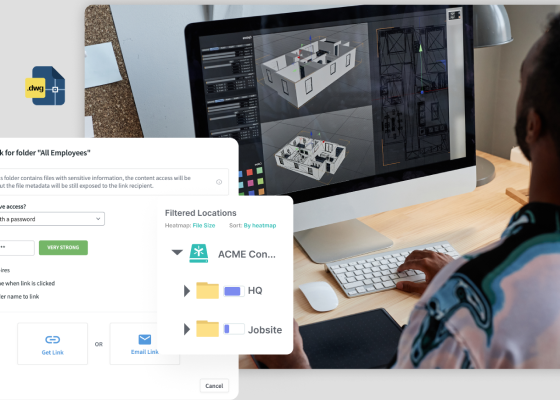Data Management Trends for AEC Professionals
Data management in construction refers to the process of collecting, storing, organizing, and utilizing data throughout the lifecycle of a construction project. Effective data management is crucial in construction due to the industry's complexity, the vast amount of data generated, and the need for collaboration among multiple stakeholders.
This article will provide insights into the impact of digital transformation in the AEC industry and the role of data management. It will explore the technology trends that are shaping the future of data as well as the associated management in this sector, both its opportunities and challenges.

Brief Overview of Data Management in the AEC Industry
Data management in construction solutions is vital to the success of architecture, engineering, and construction (AEC) industry projects—from initial proposals and design through construction and maintenance. This industry generates vast amounts of data, including architectural designs, structural plans, materials specifications, and project timelines.
Managing this data efficiently is crucial to ensure effective collaboration among stakeholders, optimal project outcomes, cost control, and on-time projects. It’s also about managing the versions b/c a document can go through many iterations through the project. It’s crucial all parties involved are on the latest version otherwise errors occur on the project.
Key elements of data management in construction include the following:
Data analysis and visualization
Analyzing construction data can reveal insights into project performance and facilitate risk management, cost control, and scheduling. With data management in construction visualization tools, data-driven insights are transformed into easily consumable formats for various stakeholders. For example, dashboards can provide real-time updates on project status, resource allocation, and budget expenditures.
Data collection
Data management in construction provides tools for gathering data from disparate sources, such as project plans, schedules, on-site sensors, drones, and software applications.
Data governance
Data management in construction supports data governance by helping to ensure consistency, accuracy, and accountability. This includes managing data across all areas of a project to maintain data quality and compliance as well as support data lifecycle management.
Data integration
Construction projects often involve many different stakeholders, each using different tools and systems. Data management in construction facilitates the integration of this data into a unified system. This allows for more efficient project management and collaboration.
Data security and privacy
Protecting sensitive project data is critical in construction. Implementing robust cybersecurity measures and adhering to data protection regulations are essential to safeguarding information from unauthorized access and breaches.
Data storage and organization
Data management in construction is increasingly leveraging cloud-based storage solutions to help organize and store the large volumes of data that are generated. They provide scalability, remote access, and collaboration features that are essential for data management in construction. With data management, information is readily accessible for project use and analysis.
Traditional data management in construction relied heavily on manual processes and paper-based documentation. The digital systems that were used tended to be fragmented. While the underlying frameworks and processes were sound, traditional approaches to data management in construction were inefficient, error-prone, and not conducive to collaboration across distributed stakeholders and team members.
The following quick review of traditional practices provides context for the digital shift in data management in construction. Foundational elements of traditional data management in construction include:
- 2D CAD systems were the standard for creating building designs and drawings, limiting the ability to visualize and analyze designs in a comprehensive manner.
- Decentralized data storage resulted in project information being stored across various locations, from filing cabinets to individual computers, making accessing and retrieving specific data challenging, especially for large and complex projects.
- Limited collaboration, since most collaboration occurred through meetings, phone calls, and the exchange of physical documents, limiting opportunities for real-time collaboration.
- Manual data entry and processes many tasks, such as drafting, scheduling, and calculations, were performed manually. This was not only time-consuming but also increased the risk of human error.
- Paper-based documentation for everything from design drawings and specifications to contracts and project schedules made sharing, updating, and storing information cumbersome and prone to errors.
- Reactive rather than proactive decision-making due to a lack of tools to enable real-time data analysis and predictive analytics, leaving project teams to rely on past experiences and best guesses.
- Siloed data and systems used by teams from each discipline within a project (e.g., architecture, engineering, construction management) with their own sets of tools and databases, which led to data silos. This not only inhibited sharing and collaboration but also limited analytic capabilities.
Emerging Trends in Data Management for AEC Professionals
Emerging trends for data management in construction reflect the AEC industry's digital transformation. These trends leverage technology to improve efficiency, accuracy, and collaboration across all stages of construction projects. Among the key emerging trends for data management in construction are the following:
Artificial intelligence (AI) and machine learning (ML)
AI and ML are increasingly being used as part of data management in construction to analyze vast amounts of data to power predictive analytics that optimize risk assessments and provide precision decision support. These technologies can also automate a variety of functions, including design analysis, project scheduling, and safety compliance monitoring. The use of AI and ML as part of data management in construction increases productivity and reduces human error.
Building Information Modeling (BIM) Evolution
BIM has moved beyond 3D modeling to incorporate fourth, fifth, and sixth dimensions—4D (time), 5D (cost), and even 6D (sustainability). This makes the already powerful BIM systems an even more powerful element in data management in the construction ecosystem. These systems enable more comprehensive project management and planning, as well as better integration and analysis of data, to improve decision-making and project outcomes.
Cloud-based collaboration platforms
The addition of cloud-based platforms to the ecosystem of data management in construction has dramatically improved data storage, sharing, and collaboration among stakeholders. These platforms facilitate remote access to data and systems, which helps teams work together more effectively and efficiently and provide timely updates to clients.
Cybersecurity for data management in construction
As the AEC industry becomes more digitized, the importance of cybersecurity for data management in construction grows. AEC projects collect large amounts of sensitive data that must be protected to adhere to compliance and client requirements. Traditional systems are quickly being replaced by more sophisticated systems that provide protection throughout the lifecycle of data management in construction.
Digital twins
Digital twins take data management in construction to an entirely new level. By providing an exact digital copy of a physical asset, process, or system, digital twins are used to simulate building performance, monitor construction progress, and manage the lifecycle of a building from design through demolition. The real-time, highly precise data provided by using digital twins helps AEC professionals to predict issues more accurately, streamline operations, and support data-driven decisions.
Integrated project delivery (IPD)
The trend towards more integrated and collaborative project delivery methods, facilitated by shared data environments and data management in construction, is improving project outcomes. IPD leverages shared databases and processes to enhance teamwork and alignment among all project stakeholders.
Internet of Things (IoT) and sensors
Real-time information collected by IoT devices and sensors (e.g., equipment usage, worker productivity, and environmental conditions) is being integrated into systems for data management in construction. With proper data management, this data is organized and readily accessible to level up many parts of AEC projects, including resource allocation and tracking, safety measures, and all parts of operations.
Sustainability and green building
Data management in construction is playing a crucial role in enhancing sustainability by enabling advanced data analytics with rich sets of clean, reliable data. Analyzing data related to energy usage, material waste, and environmental impact, AEC professionals are able to design and build more sustainable structures.
Impact of Digital Transformation on Data Management
The impact of digital transformation on data management in the AEC industry is profound. The adoption and expanding use of digital tools are transforming traditional practices. With these changes, the ability to effectively manage and leverage data is increasingly critical to secure and hold a competitive advantage. Digital transformation comes with challenges, but it is widely agreed that the benefits far outweigh them. Consider the following commonly cited challenges and benefits of digital transformation on data management in construction.
Challenges of Digital Transformation on Data Management in Construction
Data security and privacy complexity
Digital transformation brings significant security and privacy challenges arising from increased demand related to data management in construction. The expanded digital footprint creates a larger cyber attack surface that is more vulnerable to cyber threats and data breaches than traditional approaches.
Organizations must implement more secure data management systems and comply with data protection regulations.
Disparate systems
Interoperability between different systems and software remains a challenge with digital transformation. It impacts data management in construction by requiring standardization and integration efforts.
Importance of Data Security and Privacy in the Digital Age
With the shift to digital, cybersecurity has become a paramount concern. Protecting sensitive project data against breaches and unauthorized access is crucial.
Compliance with data protection regulations (like GDPR) necessitates robust data governance and security protocols.
Increased volume of data
The increased volume and variety of data generated by digital tools can overwhelm traditional data management systems. As part of a digital transformation initiative, data storage needs to be considered and, in most cases, will need an upgrade to meet the requirements that come with an increased volume and variety of data inputs.
Benefits of Digital Transformation on Data Management in Construction
Advanced simulations
Powered by data management in construction, BIM and digital twins aggregate vast amounts of data to offer a multidimensional view of projects. This provides AEC professionals with real-time simulation and analysis capabilities to optimize designs and operations.
Better decision-making processes
Digital transformation enhances data data management in construction with increased accessibility and visibility. This allows AEC professionals to leverage advanced analytics to identify patterns and trends to support data-driven decisions (e.g., budgeting, scheduling, and forecasting).
Enhanced efficiency and productivity
Digital transformation enables the automation of routine tasks (e.g., data entry, calculations, and compliance checks), which can significantly improve efficiency and productivity. This also reduces manual errors that slow projects. In addition, digital tools help optimize resource allocation, track progress in real-time, and streamline workflows, further enhancing project efficiency.
Expanded data accessibility and mobility
With cloud storage and mobile technology, project data is accessible anytime, anywhere. This streamlines and speeds up construction projects by enabling decisions to be made on-site and in real time. Remote mobile access also reduces downtime and ensures that project teams can respond swiftly to any issues or changes.
Improved risk management
Digital data management in construction provides tools for better risk assessment and management. By analyzing historical data and current project data, construction managers can identify potential risks earlier and develop strategies to mitigate them. Additionally, digital tools can monitor compliance with safety standards and regulations, improving on-site safety and reducing the chance of accidents.
Streamlined collaboration across project teams and stakeholders
Digital platforms and data management in construction enable seamless collaboration across project stakeholders and team members, with everyone having access to the same, up-to-date information. This reduces conflicts and miscommunications, leading to more cohesive and integrated project delivery and minimizing delays and rework.
Best Practices for Effective Data Management
Following data management in construction, best practices is crucial for AEC firms to navigate the complexities of modern construction projects effectively. The following are commonly cited best practices that are proven to enhance data management in construction strategies and result in more efficient project execution, reduced costs, and improved project outcomes.
Create standardized data protocols
Establish clear protocols for how data is formatted, stored, and shared, including standardizing file formats, naming conventions, and data entry procedures to ensure consistency and accuracy across the project.
Embrace data analytics and artificial intelligence (AI)
Utilize data analytics and AI tools to analyze project data and derive actionable insights to help predict project outcomes, optimize resource allocation, and enhance decision-making processes.
Establish a common data environment (CDE)
Centralize data storage by using a CDE as a source of truth for all project-related data and documentation, with all project information accessible from a single location.
Implement quality control processes
Establish quality control procedures to maintain data accuracy and integrity to support data management in construction systems and processes. This should include regular data audits and validation checks to identify and correct errors.
Prioritize data security and privacy
Integrate robust cybersecurity practices into all aspects of data management in construction to protect sensitive project data from unauthorized access and data breaches.
Utilize cloud-based solutions
Adopt cloud-based platforms for data management in construction to streamline storage, access, and sharing with scalability, flexibility, and real-time collaboration capabilities.
Opportunities with Data Management in Construction
Digital transformations are revolutionizing data management in construction, presenting unparalleled opportunities for innovation and competitive advantage. By coupling advanced digital technologies, such as AI, machine learning, and IoT, with data management in construction, AEC companies are seeing significantly enhanced operational efficiency, reduced costs, and improved project outcomes.
This shift towards integrated and digital data management methods, including BIM and cloud-based collaboration, overcomes the limitations of traditional practices, fostering a more efficient, accurate, and collaborative project delivery process. As a result, AEC firms that leverage these innovations stand out in a competitive market by delivering higher-quality projects more efficiently.
Egnyte has experts ready to answer your questions. For more than a decade, Egnyte has helped more than 17,000+ customers with millions of users worldwide.
Last Updated: 14th May, 2024


